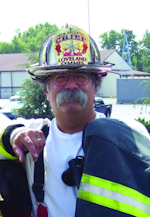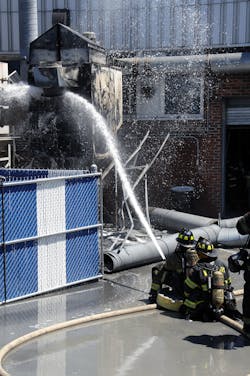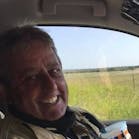Close Calls: Ductwork Falls on Firefighter at Industrial Fire
The Westbury Fire Department (WFD) is located in Nassau County, NY, just outside of New York City on Long Island. On June 22, 2015, Westbury firefighters responded to a known hazardous manufacturing plant for a reported fire. As members were operating, in coordination with the plant’s management and mutual-aid companies, there was a collapse of ductwork, trapping and seriously injuring one firefighter. The collapse was caused due to the ductwork having a significant buildup of materials that got heavier as water was applied and absorbed.
Last month’s account of the incident included the perspective of Assistant Chief Ken Gass Jr. as well as that of Firefighter Adam Accardi, who suffered significant injuries at this fire. This month, we’ll get the perspective of Assistant Chief John Bartunek, and I’ll present some observations and recommendations based on my review of the incident.
Assistant Chief Bartunek’s perspective
On June 22, 2015, I was alerted to a reported structure fire at Oerlikon Metco on Prospect Avenue in Westbury. I knew the type of business it was along with the hazards that were involved.
Upon arrival I was asked by the Chief of Department Doug Ingram to relieve him as the Command Post (he needed to leave due to family obligations). I was informed that a dust collector in the rear of the building was on fire. A 2½-inch line was putting water on the fire and a 5-inch supply line was feeding the engine. A second 2½-inch line was in operation on the roof.
I was in the process of coordinating the arrival of the mutual-aid apparatus and working with the Nassau County Office of Emergency Management and the Nassau County Fire Marshal’s Office to set up a rehab tent and ensure that the air quality was acceptable. This was so that we could decide if we needed to evacuate the Board of Educational Cooperative Services Training School, which is adjacent to the fire building, and move the Command Post and rehab area to a different location.
It was while we were in that process that I heard Assistant Chief Gass transmit an URGENT over the radio. I immediately transmitted an order for everyone to clear the air due to an URGENT message being given. Gass stated that there was a collapse in the rear of the building with a firefighter trapped.
I instructed the FAST/RIT team from the Syosset Fire Department (58), along with Medic Sandra Sammartino from our neighboring Jericho Fire Department, to respond to the rear of the building.
Further transmissions confirmed the firefighter was freed from the collapse and being evaluated. I was informed that the firefighter had sustained a serious leg injury during the collapse and that he was immobilized, treated and transported to Nassau University Medical Center for further medical treatment.
After the incident, we had a critique to discuss what had happened and how we could prevent this from happening in the future. Below are some of the issues discussed:
- Being more aware of the collapse zone—not just the building but also any attached structures.
- Expect the unexpected—never take anything for granted.
- Remember that water weighs 8.344 lbs. per gallon and is weighing down whatever you are applying it to.
- Know your surroundings and be able to identify potential hazards, specifically the building in your response area.
- Preplan, preplan, preplan.
- Consider the need for a RIT at any call—and not just structure fires.
- Get all your resources rolling early because if you wait too long they may not be there when you need them; further, you can always turn them around.
From Chief Goldfeder
I am real familiar with the WFD—a 100 percent volunteer fire/rescue and EMS department that covers a busy community with a wide range of occupancies to protect. With little exception, if you can name it, the WFD protects it:
- Millionaire mansions and large private estates? Yes
- Working-class housing? Yes
- Low-income subsidized housing? Yes
- Interstate highways? Yes
- Railway? Yes
- Massive big-box stores? Yes
- One of the nation’s busiest shopping malls? Yes
- Industrial/hazmat? Yes
- Numerous houses of worship? Yes
- Commercial/strip stores? Yes
- Downtown areas? Yes
- Mid-rise buildings? Yes
- Recycling industrial sites? Yes
- Institutional/schools? Yes
(I could keep going.)
When it comes to knowing your area, there is no other way to do that than to PREPLAN. Just imagine if the WFD was dispatched to this location with no prior knowledge or information about this building. Imagine if they were not aware of what was done in that facility. Fortunately, the WFD was aware of what the facility was used for—and even so, there was a somewhat unique collapse resulting in a firefighter injury. This only further drives home the point that we must preplan and prepare.
Like a football team, well before "the game” they are studying and working to understand the opposing team, the "other side,” the “enemy.” As the late Frank Brannigan taught us: Know your enemy—the building is your enemy. The only way to do that is to study that building and anything that is attached to or a part of the building, including exposures. Have a game plan (preplans) based on the building and what’s in it. Have a playbook (operational policy or guidelines) so companies understand their roles and responsibilities of what to do—and what not to do—based on the information that’s gathered prior to any fires.
Responding to a fire is like being set up on a blind date. The more information you know beforehand, coupled with a proper size-up upon arrival, can result in a much better outcome!
Part of preplanning is understanding what the building is used for and, as a part of that, what will happen when operations start and water is applied to the structure itself and/or materials within. Understanding the impact of our actions before we take those actions is critical at the firefighter, company officer and command levels. Fortunately, when the collapse occurred, there was a division supervisor in the area, but he was out of the immediate hazard zone, enabling him to observe, transmit the need for help and then immediately supervise and assist in the firefighter’s removal. We have reviewed many incidents (and NIOSH reports) where there was no area supervision or the supervising officer who was supposed to stay back but didn't and then became a victim (became part of the problem), rendering themselves useless in doing what was needed.
While we all may want to "get in the action," that's not necessarily what is needed by chief-level officers. Division supervisors may be expected to take a step back and not be in the hazard zone, and sometimes for no other reason than that is their job! When you are covering the Bravo or Charlie side, you are the eyes and ears of command. You can't do that when you are performing tactical tasks. In this case, Chief Gass was in a good position to immediately observe, report and then take action. If he had been with the crews on that line, he very well may have become trapped as well, unable to do the job he was most needed for—supervising and monitoring conditions. If you are a division supervisor, do that. Supervise, monitor conditions and protect the members doing their job; that's what they expect from us.
As Chief Bartunek noted above, a collapse zone includes anything that may collapse, not just the building. When first-arriving firefighters and their officers arrive, followed by division supervisors, make sure that your size-up(s) include a look at the big picture to determine what might collapse. This could be anything from utilities to radio towers to overhangs to extenuating manufacturing equipment—whatever could fall from the fire, the application of water or anything else that changes during the fire. In determining the best positioning for firefighters operating on the fire, make sure you also consider what might go wrong at that specific location (above, behind, in front of, nearby), and then place your crews based upon the size-up needs, life hazards, and the members’ ability to perform and survive.
When do we need a rapid-intervention team? Anytime our members may need to be rapidly intervened! So no matter what the conditions, well before companies arrive, consider a team to be initially dispatched on your first alarm of fire based upon verbal reports. If you arrive and conditions are confirmed negative, then return them. But if you arrive and you have a working incident and something goes wrong in those precious first 5 minutes, you will be more than glad to have your rescue resources on scene, or at least already on the way. When there is a mayday and a RIT team has yet to be dispatched, it's simply too late. Fortunately in this case, the WFD leadership had a team on scene (along with EMS/ALS resources) before the mayday.
Firefighter Adam Accardi is well on the way to recovery and that's a good thing. No other members were hurt in this incident, and the emergency was handled professionally by the WFD with their mutual-aid partners. The WFD was aware of what they were getting into and took action before the fire (by understanding the building and its contents prior to the fire) and during the fire (multiple resources called early to operate and to stage).
In sum
We go to places where our mere arrival can be risky and not always predictable. In this case, one firefighter was injured due to water being applied to an area that contained discarded materials (build up) that absorbed the water (adding weight due to no run off) and, subsequently, the ductwork collapsed. So while a member was hurt, crews could immediately deal with it due to divisional command officer positioning (supervision in the areas where members are operating), a well-defined incident command structure and tactical plan, good communication, adequate operating resources along with resources in staging ready to immediately deal with the emergency.

Billy Goldfeder
BILLY GOLDFEDER, EFO, who is a Firehouse contributing editor, has been a firefighter since 1973 and a chief officer since 1982. He is deputy fire chief of the Loveland-Symmes Fire Department in Ohio, which is an ISO Class 1, CPSE and CAAS-accredited department. Goldfeder has served on numerous NFPA and International Association of Fire Chiefs (IAFC) committees. He is on the board of directors of the IAFC Safety, Health and Survival Section and the National Fallen Firefighters Foundation.





